be quiet! Dark Power Pro 11 550W Power Supply Review
Peter Donnell / 9 years ago
Introduction & Packaging
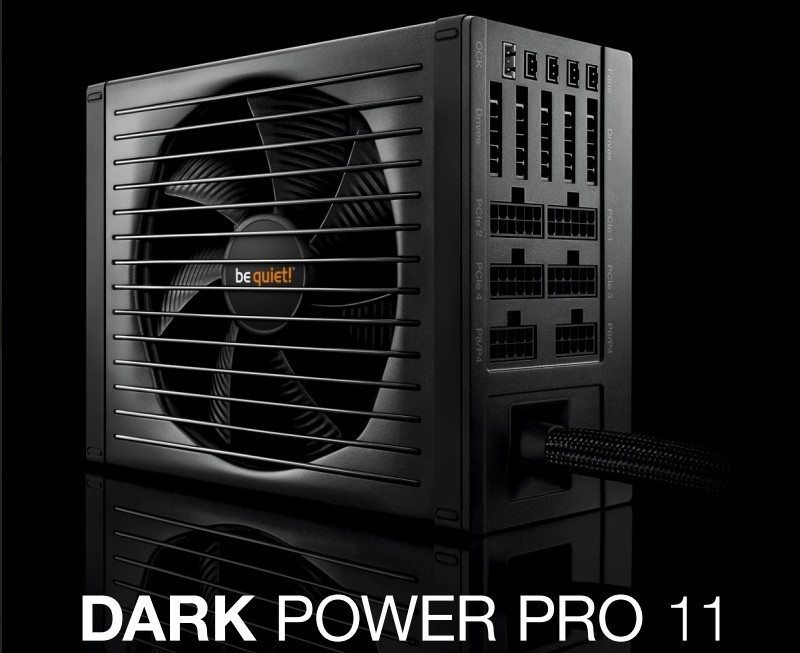
It’s no secret that be quiet! make some of the best PSUs money can buy, we’ve seen time after time that they can deliver great looking and performing products. A few months ago, we took a look at one of their latest and greatest units, the Dark Power Pro 11 1200W PSU and it was certainly impressive, offering excellent power delivery, whisper quiet performance and gorgeous aesthetics, but what if you don’t need huge amounts of power for your system, but you still want a very high-quality unit? That’s where the new Dark Power Pro 11 low-wattage models come into play.
“The Dark Power Pro 11 is the most advanced high-end power supply from be quiet!. Massive power, Overclocking Key, which can switch between quad and single-rail operation, an almost inaudible performance due to a be quiet! SilentWings 3 fan and – for us – the highest efficiency certification in the form of 80PLUS Platinum are some of the features of the new Dark Power Pro-models.” – be quiet!
At our disposal today, we have the Dark Power Pro 11 550w, offering more than enough power for a single-GPU system, workstation, office system or HTPC. Don’t think lower wattage means less features though, as you’ll still find 80 Plus Platinum efficiency, semi-modular cables and premium grade build-quality throughout.
Packaging and accessories
The box is nicely designed and features the typical black design we see on all be quiet! products. What is interesting is seeing the “high-end” branded together with 550W, as lower wattage units are rarely high-end.
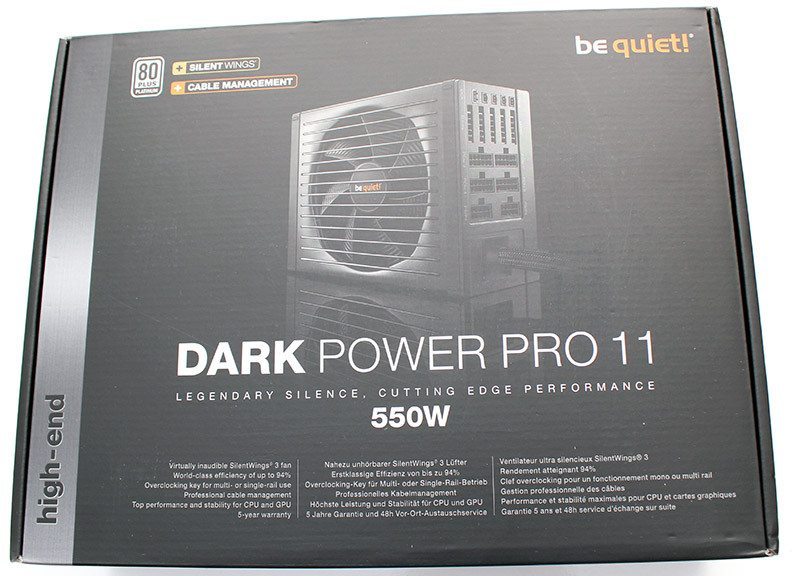
Around the back, a quick run-down of all the included cables and features, but we will, of course, take a much closer look at these in a moment.
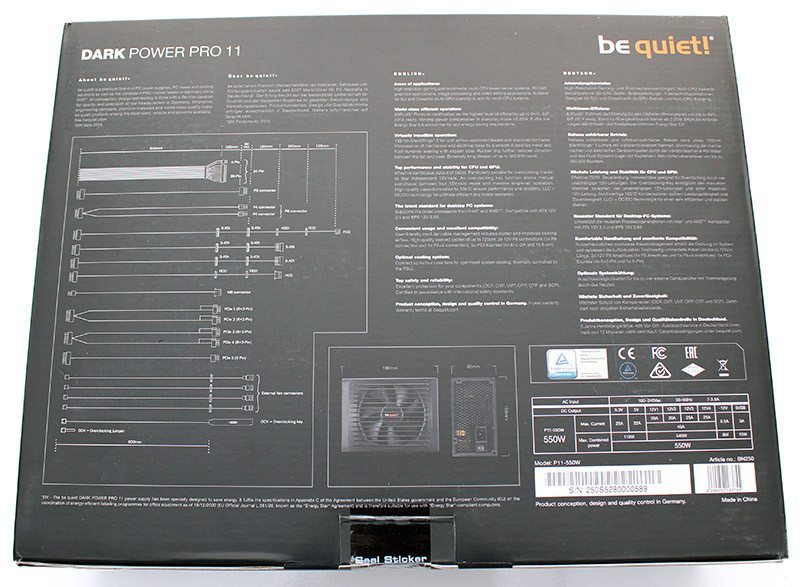
In the box, you’ll find the AC power cable, user manual, OC key, fan cables and a collection of cable ties. The OC key is a nice touch, as it can be mounted in a space PCI-e expansion slot, giving you a physical switch for toggling between single and multiple rails on the PSU; not everyone will need such a thing, but it’s nice to have. The other welcome addition is the fan extension cables, as the PSU can have fans connected directly to it.
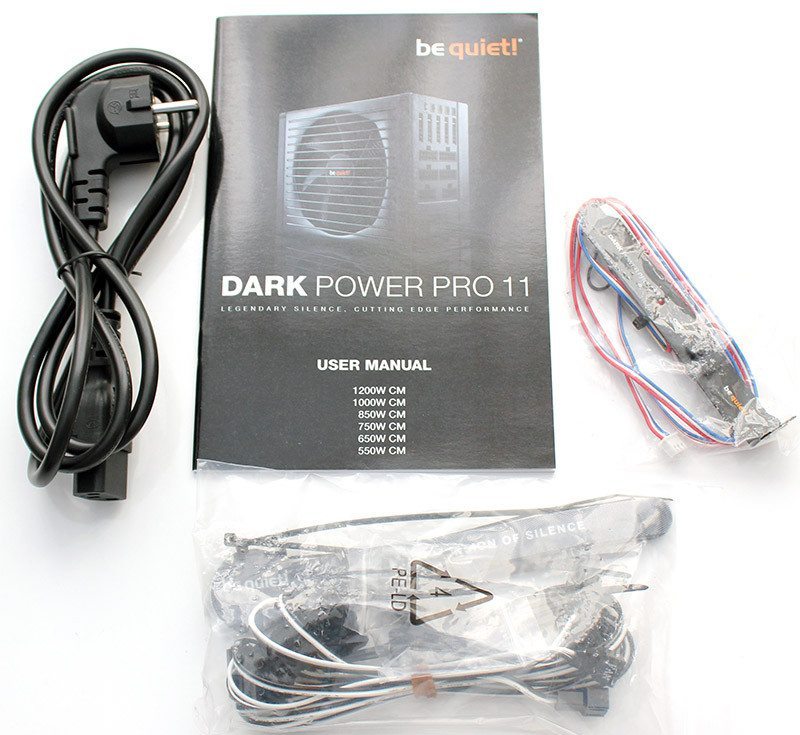
A Closer Look – Exterior
Power Supply Unit
First impressions of the power supply are very good, it’s got all the premium build quality and design that we’ve come to expect from be quiet! Tough exterior, anti-vibration mounts and a gorgeous paint job.
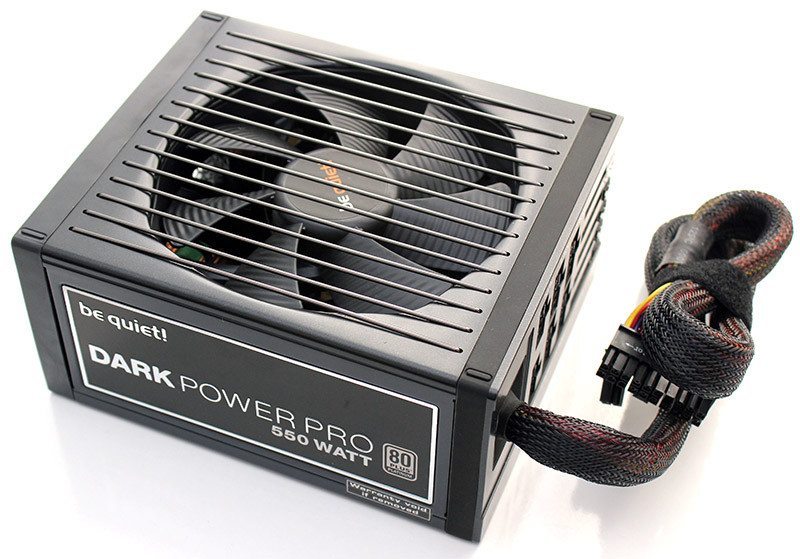
The fan grille is really nicely designed with thick rails passing over the be quiet! 135mm fan. As you can see here, the 24-pin cable is hard-wired, but since you’re absolutely going to need this one, I see no issue with this.
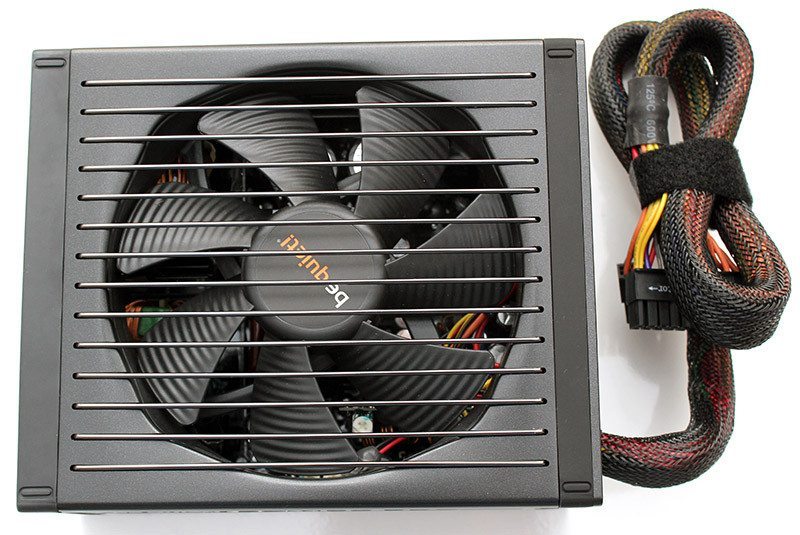
Down one side we’ve got a slightly reflective finish on the branding, with slightly embossed lettering, which is the same on each side of the unit.
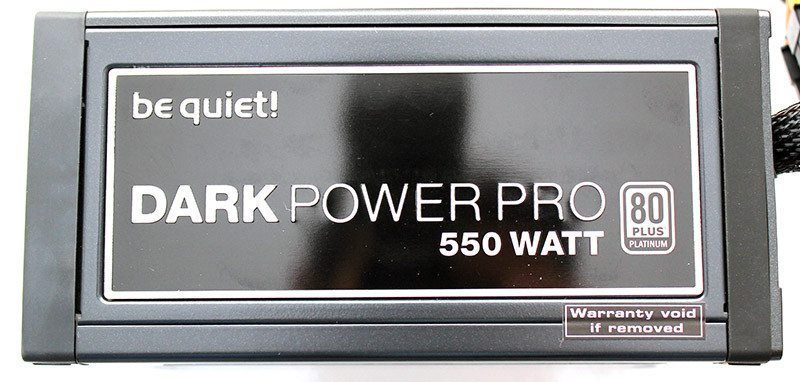
On the base, you’ll find the specifications sticker. Here we can see that the unit can provide 45A on the 12V rails, more than enough power for a decent GPU and other devices.
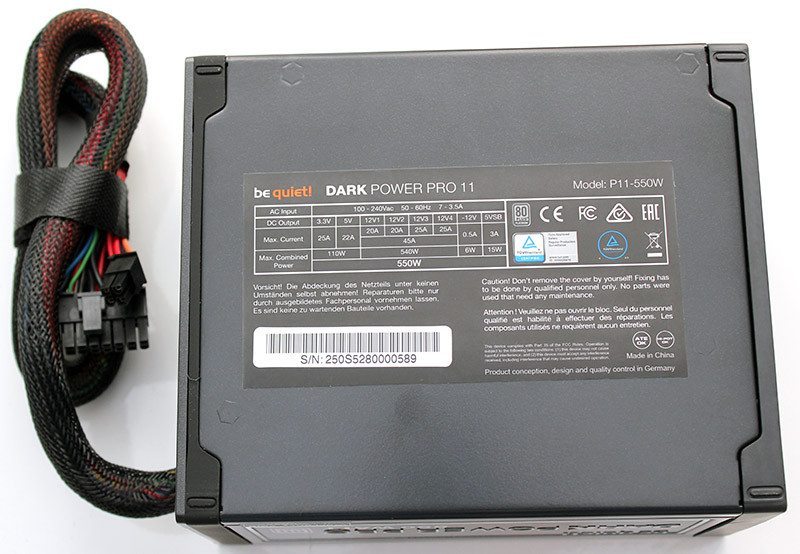
Lots of ventilation around the back, as well as a thick rubber strip around the outside, which will help provide an air tight anti-vibration fitting to your chassis.
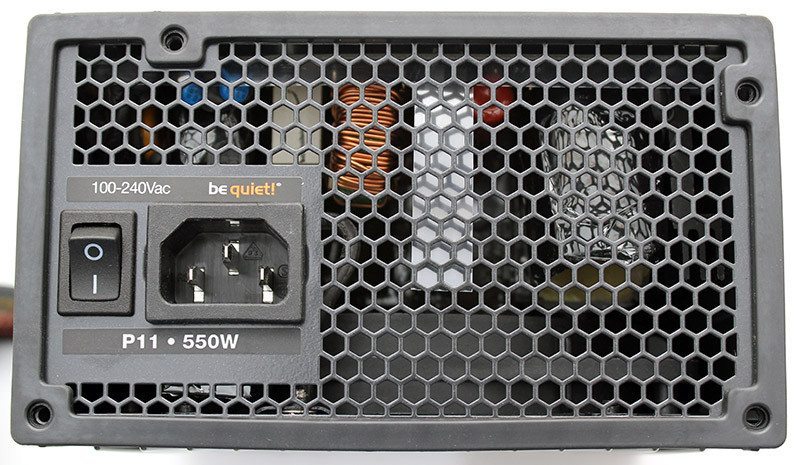
On the left side, you’ll find four fan connectors, which can be used in conjunction with the fan cables that are included in the box, as well as the OCK connection header. There are five peripheral connectors for storage drives and similar devices, four 12-pin PCIe connectors and two 4+4 pin headers for motherboard/CPU power.
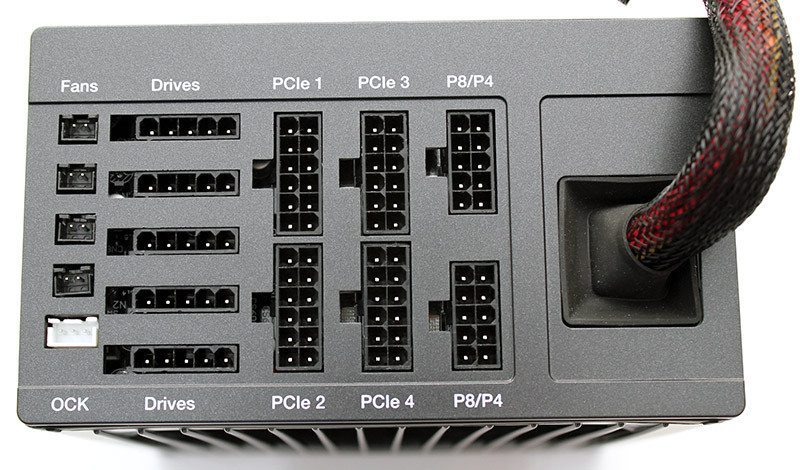
Cabling
The included cables are of a good quality with durable headers. The cable braiding isn’t the best looking, but it is well made and will do a great job of protecting your cables for wear. Here you can see we’ve got two 6+2 headers for each of the two 12-pin cables, more than enough to connect a dual-GPU configuration. There’s also an 8-pin and a 4+4-pin CPU power cable.
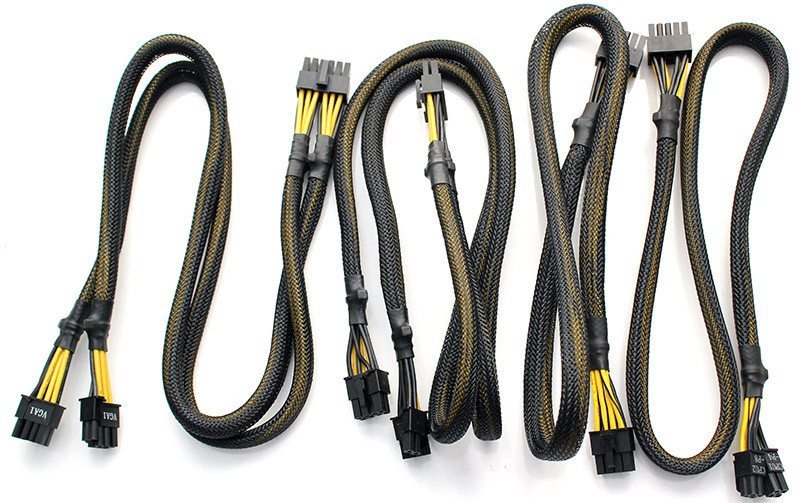
A good mixture of Molex and SATA cable, as well as a FDD header, more than enough to connect all of your storage devices.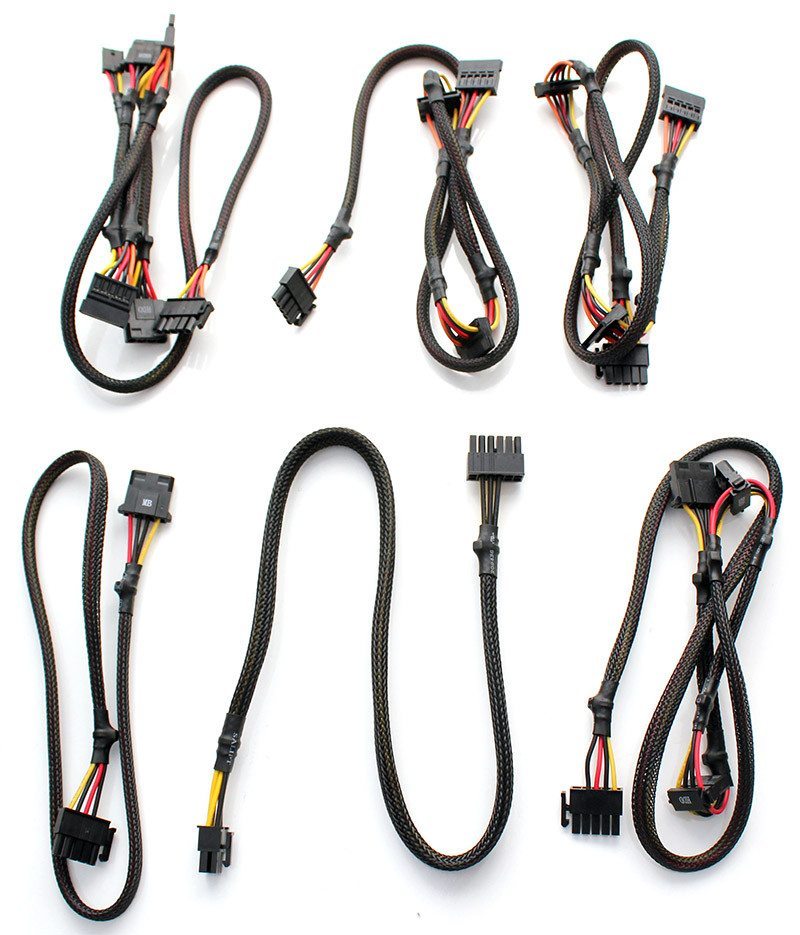
A Closer Look – Interior
The interior of the PSU looks quite busy, there’s certainly more hardware in here than I was expecting for a lower wattage unit, although that’s not necessarily a bad thing. There are quite a few cables passing through the unit, but they’re kept to the side so not to interfere with airflow around the main power delivery components, which obviously want to be kept as cool as possible. Aside from the main PCB, you’ll also find six smaller daughter boards, which helps keep a lot of the layout clear, increases airflow and will also help with heat dissipation.
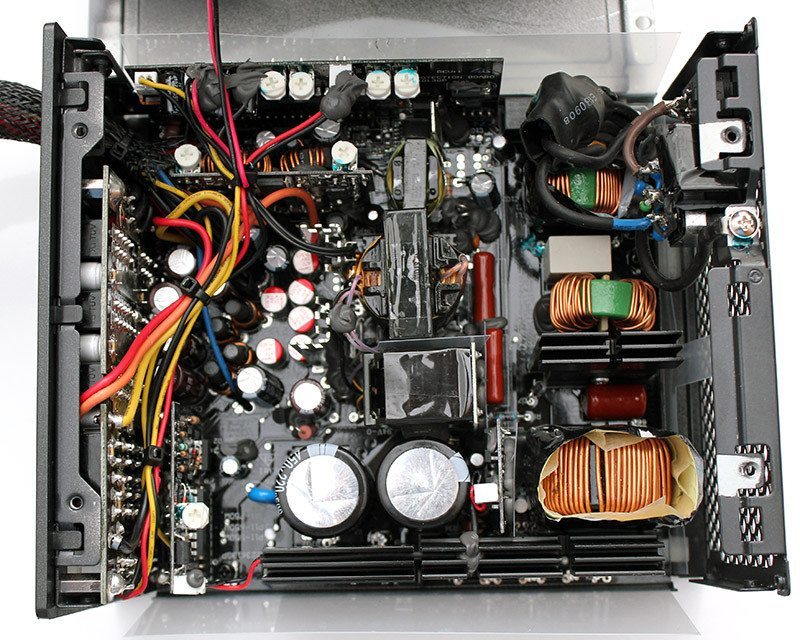
There’s not one, but two! main bulk capacitors in this PSU, which is something I’ve never seen in a lower wattage unit. This capacitor is rated for 450v, 220uf @ 105c.
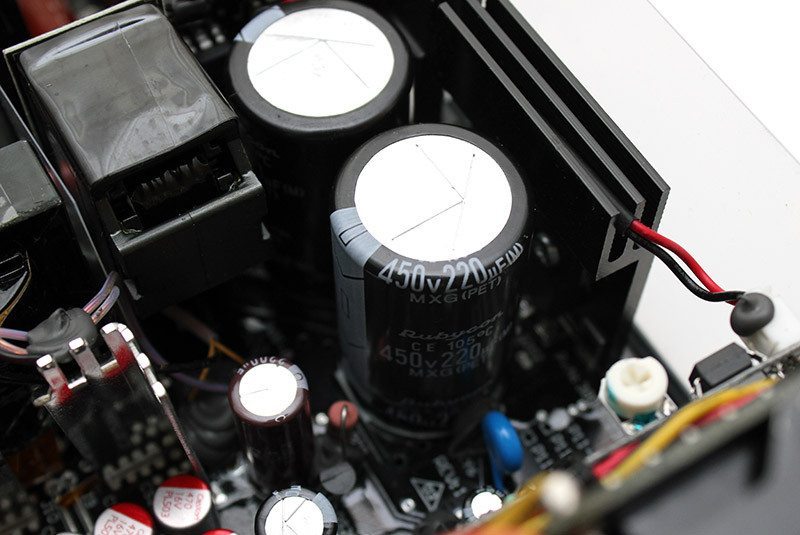
As I said before, there are a few cables causing a little clutter inside this unit and to prevent shorting connectors, or cable from becoming detached, they’ve been firmly glued into their headers and a few cable ties have been applied, so there’s certainly signs of a little extra thought going into the build process. At the back, you can see the protection board, which will help with voltage control and fan regulation. In front of that, you can see the smaller DC/DC board for 3.3 and 5V delivery.
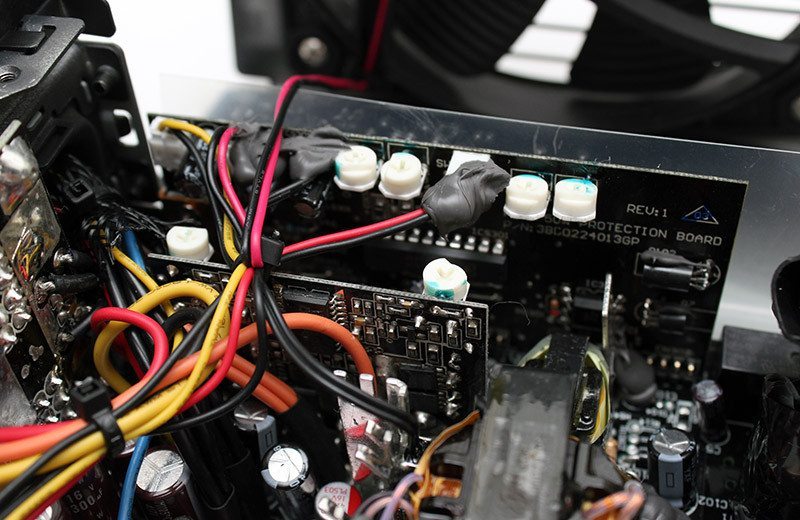
All of the caps used here are high-quality, and that will play no small part in delivering this units promised 80 Plus Platinum efficiency rating; these are backed up by secondary 28 aluminium solid output capacitors on the output PCB, which will allow better management of any spikes from your hardware, such as the GPU.
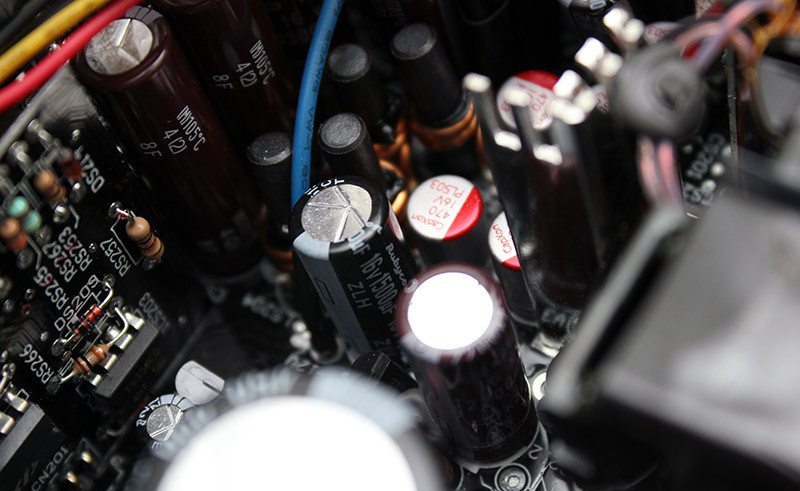
The EMC/EMI filter, the first step in delivering clean power to the PSU and your system.
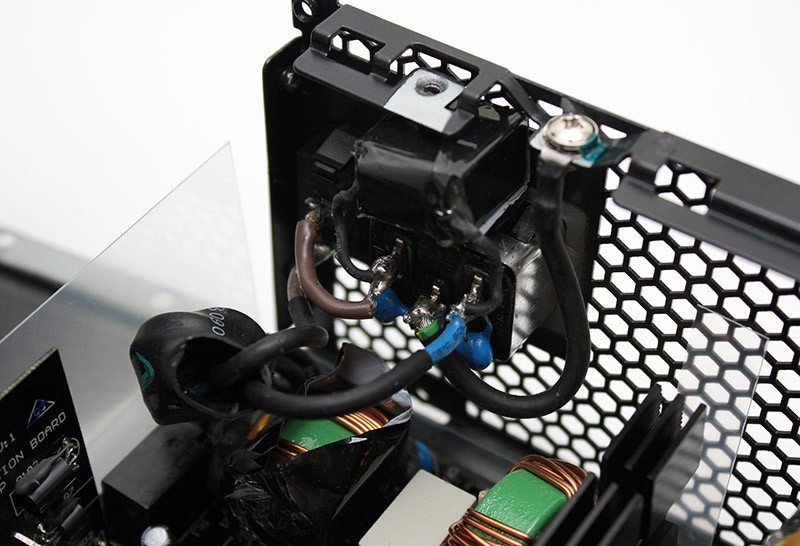
We’ve already seen the best hardware used in the main PSU, which should virtually eliminate any coil whine and other issues, but this is also backed up by a very high-quality Silent Wings 3 135mm fan.
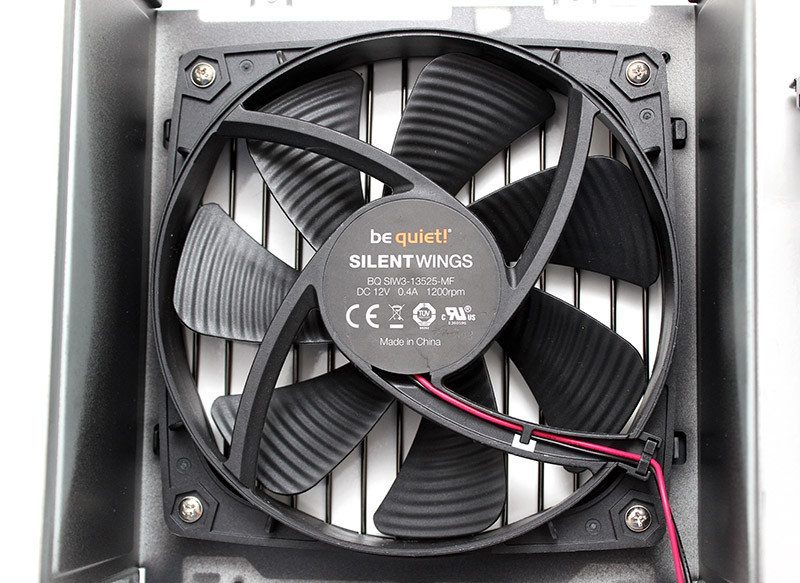
Test Procedure
At eTeknix we take the power supply testing procedure very seriously and have invested a lot of resources into acquiring the appropriate testing equipment. For all power supply reviews we test the power supplies with dedicated power supply testing equipment. This means we are able to get the most accurate results from our testing as opposed to using software benchmarks (such as OCCT) or multi-meter readouts which are broadly inaccurate.
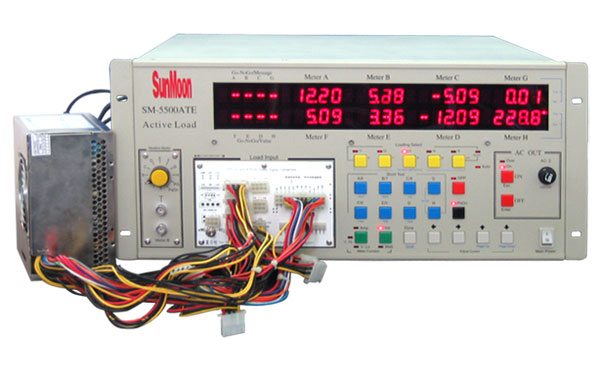
Our test machinery is as follows:
- Sunmoon SM-5500ATE Active Load Tester (1200W rated)
- Stingray DS1M12 USB Oscilloscope
- Voltcraft DT-10L laser tachometer
The eTeknix test procedure involves:
- Testing each power supply at 20/40/60/80/100% load (with balanced load across all rails) and measuring PFC (power factor correction), efficiency (actual power divided by power “pulled at the wall”) and voltage regulation (deviance from expected voltages of 3.3/5/12 on the main rails).
- Measuring ripple with an oscilloscope at 20/40/60/80/100% load.
- Measuring fan speed after a stabilisation period of five minutes at each load scenario using the Voltcraft DT-10L laser tachometer and a reflective strip on the fan.
- Testing each power supply’s OPP (Over Power Protection) mechanism and seeing how many watts each power supply can deliver before shutting down
Other things to consider are that
- We recognise that a single yellow 12 volt cable can provide only 6 Amps before overheating (which corrupts voltage regulation and efficiency) and so we used an adequate number of cables for each power supply to ensure there is not efficiency loss from poor cables selection
- Our Sunmoon SM-5500ATE power supply tester is not capable of testing more than 300W on each of the 12 volt rails so where a power supply provides more than 300W on a 12 volt rail that power is distributed over multiple 12 volt rails on the load tester. For example a power supply with one 12 volt rail supplying 750 watts would be spread equally over three 12 volt rails on the load tester, a power supply with two 450W 12v rails would be spread over four 12v rails on the load tester, two 225W 12v rails for each of the 12v rails on the unit.
- We use the same time scale and horizontal millivolt scale on our oscilloscope for all ripple tests, that is a 20ms T/DIV (horizontal) and a 0.02 V/DIV (vertical) meaning the scale is from -80mV to +80mV, ATX spec dictates that the 12v rail must fall within 150mv of ripple and the 3.3/5 within 50mv so that scale allows us to include both 150 and 50mV peaks. (Some older PSU reviews use different scales which were later ditched as the visual representation they give is inadequate, in these reviews written measurements are provided only).
- Deviance is the terminology used to represent the way voltages diverge from the expected values
Efficiency, PFC and Voltage Regulation
Voltage Regulation
To test voltage regulation we load the power supply to five different load scenarios that give an equal spread of load across every single rail. So that means 20% on all rails, 40% on all rails and so on. We then calculate the average deviance of each rail from its expected voltage.

Due to the limitations of our load tester, we had to split the 12v rail across multiple “simulated” rails. Wow, these are simply some of the best results I’ve ever seen! The results are even better than the already impressive Dark Power Pro 11 1200W unit, although this is likely due to the same high-end hardware being used to deliver less wattage; I’ll be amazed if you can find another PSU that can do much better.
Power Efficiency
Power efficiency is measured by calculating actual supplied wattage divided by the wattage drawn at the wall/plug, multiplied by 100 to give a percentage. We then compare that to the particular 80 Plus certification the company claims to see if it meets that. You can see the 80 Plus certifications below, we always test 230v power supplies.
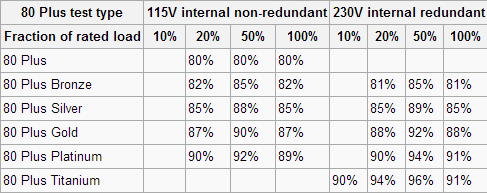
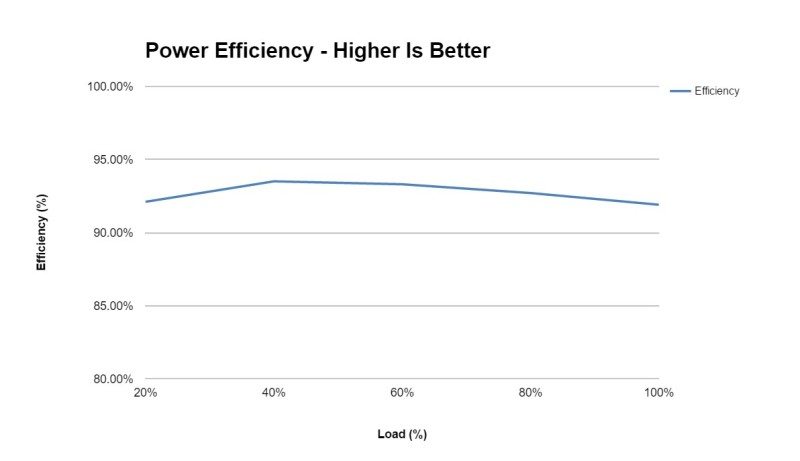
be quiet! promised 80 Plus Platinum and this power supply certainly delivered that with zero issues.
Power Factor Correction
Power Factor Correction is the ratio of the real power flowing to the load, to the apparent power in the circuit. The aim of PFC is to make the load circuitry that is power factor corrected appear purely resistive (apparent power equal to real power). In this case, the voltage and current are in phase and the reactive power consumption is zero. The closer the number to one the better as this allows the most efficient delivery of electrical power (Source – Wikipedia).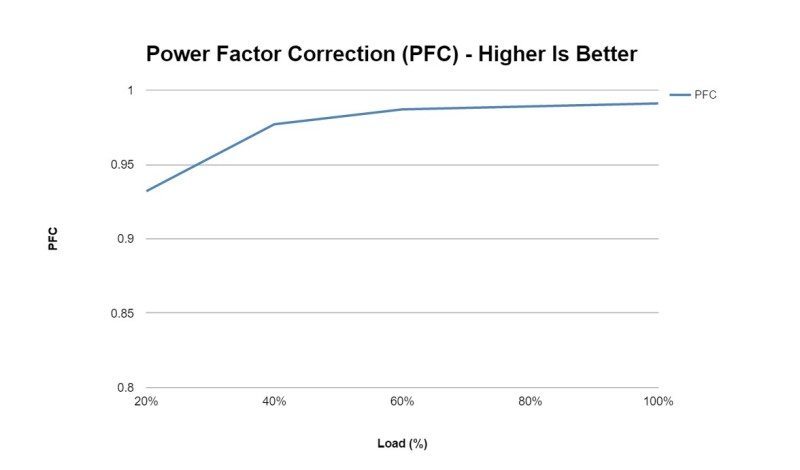
This is nothing short of amazing, just as we saw with the 1200W unit, near perfect PFC throughout.
Ripple
Noise and Ripple can easily be measured by an oscilloscope. These show how much voltage fluctuation there is on a particular rail. We tested the rail stability of the 3.3 volt, 5 volt and 12 volt rails using an identical time and millivolt scale for all graphs. millivolt ripple is measured by the peak to peak size of the voltage curve.
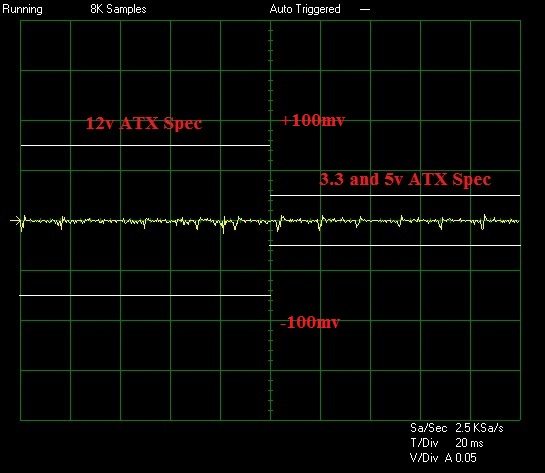
Sample Ripple Graph
The latest ATX 12 volt version 2.3 specifications state that ripple from peak to peak must be no higher than 50 millivolts for the 3.3 volt and 5 volt rails, while the 12 volt rail is allowed up to 120 millivolts peak to peak to stay within specifications. Millivolt figures are stated to the closest increment of 5 given their variability.
| Load (%) | 3.3V Ripple | 5V Ripple | 12V Ripple |
| 20 | 12.4 | 7 | 28.2 |
| 40 | 9.2 | 5.4 | 21.6 |
| 60 | 11.6 | 5.2 | 19.8 |
| 80 | 13.8 | 7.4 | 16.8 |
| 100 | 15.4 | 6.2 | 13.6 |
I think you will be picking up on a theme here, as just like every other test, the ripple suppression is superb, really clean power delivery throughout all load scenarios.
3.3 volt @ 100%

5 volt @ 100%

12 volt @ 100%
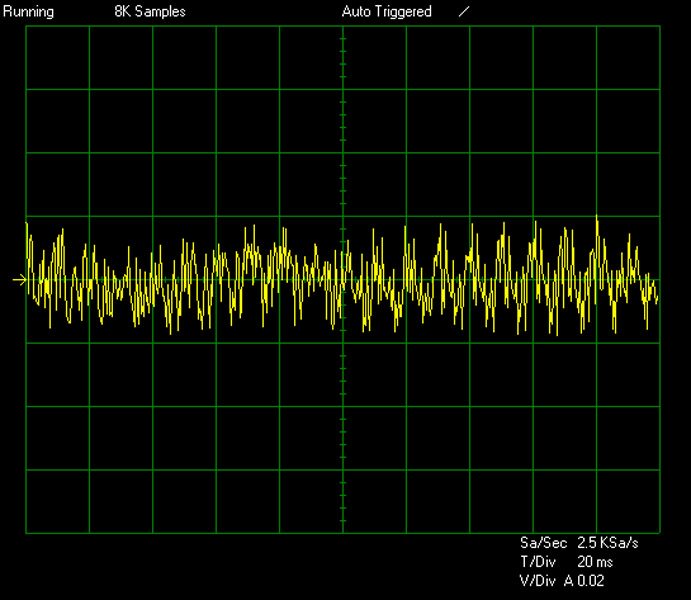
Over Power Protection and Max Wattage
Power supplies often quote as having various protection mechanisms such and the most important of these is Over Power Protection. In our testing we crank up the power draw until the power supply either shuts down (meaning the OPP mechanism is present and working) or blows up (meaning it is either not present or not working). We then note the maximum power consumption before the power supply shut down (or blew up).

I had a feeling that this PSU would run way past it rated wattage and I wasn’t disappointed, we managed to push it past 670W before the OPP kicked in and shut the unit down, giving us more than 20% of headroom should the system have any power spikes.
Fan Speed
When testing in a power supply laboratory it is difficult to take fan noise readings as the noise from the Sunmoon test equipment and air conditioning corrupts everything. The next best thing in our circumstances was reading off the fan speed with a tachometer to get an idea for the noise. The ambient temperature during testing held constant at 22 degrees, with 1 degree of variation. Each power supply had a consistent time period of 5 minutes to stabilise between each load scenario.
In my experience the following general relationships apply between noise levels and fan speeds, though it can vary greatly between the type of fan used.
- Below 800 RPM – Inaudible/Silent
- 800 to 1000 RPM – Barely audible
- 1000 – 1200 RPM – Audible but still quiet
- 1200 – 1400 RPM – Moderately noisy
- 1400 – 1800 RPM – Noisy
- 1800 RPM or higher – Intolerable
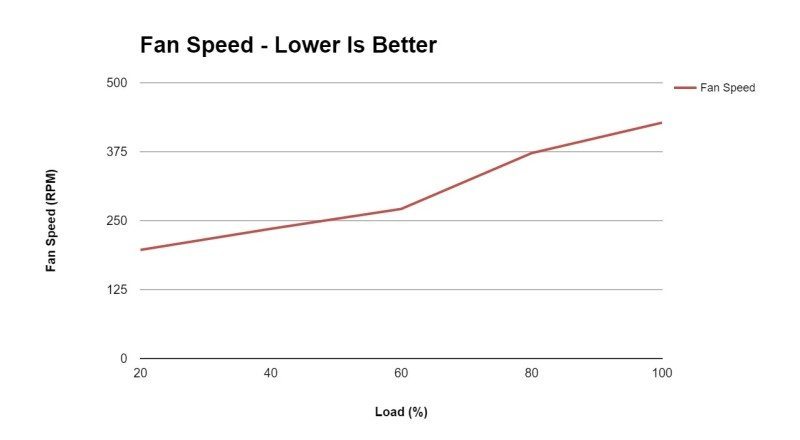
The fan in this system is bordering on lazy, it didn’t get past 500RPM and was as quiet as a passive PSU. Of course, it’s not really a lazy fan, as it kept the unit cooled just fine.
Final Thoughts
Pricing
OK, you folks knew this way coming, this may be a lower wattage design, but this is not a cheap power supply, that much is obvious from the testing pages. The saying “you get what you pay for” rings loud and clear here, you want one of the best PSUs on the market, you’ll need to dig a little deeper in your wallet and after what I’ve seen in our tests, I’m happy to say it’s worth every penny.
- be quiet! DARK POWER PRO 11 550W £115 / €154 / $149
- be quiet! DARK POWER PRO 11 650W £130 / €175 / $164
- be quiet! DARK POWER PRO 11 750W £150 / €199 / $179
Conclusion
When I tested the 1200W unit of the Dark Power Pro series, I was very impressed and still regard it as one of the best high-end PSUs on the market, it even won our Extreme Performance Award! When I heard we were getting a low-wattage model, I can’t say I was overly excited, as lower wattage units are rarely regarded as “high-end” and often associated with budget models. Of course, that really wasn’t the case here and despite the lower power output, this is very much a high-end PSU with premium grade features, enthusiast levels of efficiency, power delivery and more.
The be quiet! name prides its self on being just that, quiet! The fan spins so quiet on this power supply that you’re never going to hear it; it’s comparable to passive cooled PSUs. You may not hear the PSU, but you can certainly see it, so it’s nice to see that be quiet! hasn’t skimped on the exterior design and you’ll be proud to show off its premium paint job and overall finish in your system. prettier cable braiding would also be nice, but I must admit, that’s hardly a deal breaker.
Power delivery was excellent and I was impressed most of all by the PFC and the voltage regulation, as this unit provided us with some of the tightest results we’ve ever seen, combined with excellent ripple suppression, high levels of efficiency, a virtually inaudible fan and more. Then we’ve got a bonus features such as the OCK for switching the rails from single to multiple modes as well the built-in fan headers, giving you a huge amount of flexibility on how you want to use it.
Pros
- Modular cables
- Extremely quiet fan
- Amazing voltage regulation, PFC and ripple suppression
- 80 Plus Platinum efficiency
- Capable of running 20%+ higher than rated
- OCK
- Built-in fan headers
Cons
- Cable braiding
Neutral
“be quiet! have done it again, delivering the kind of performance we would normally see in enthusiast grade high-end units for those who don’t need super-high levels of wattage. If you want flawless performance, build quality and more, this is the unit to get!”

be quiet! Dark Power Pro 11 550W Power Supply Review
Thank you be quiet! for providing this review sample.



















